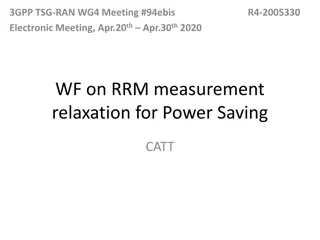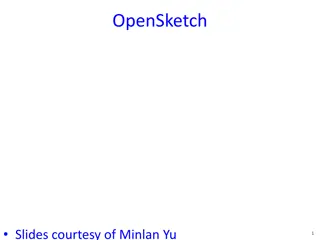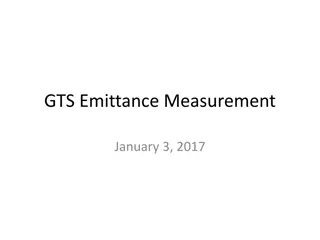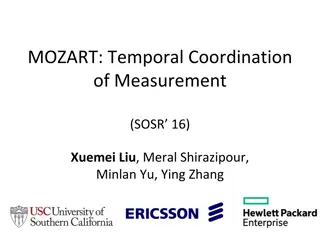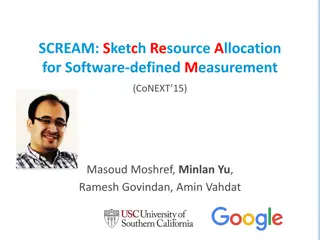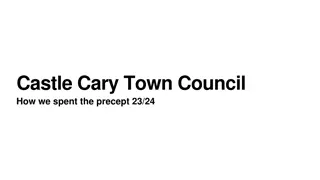
Passive Network Measurement Techniques
Explore the collection of data through IPFIX for traffic measurement and BGP routing tables for interdomain routing measurement. Learn about network flows, routing information, and the analysis of network traffic patterns.
Download Presentation

Please find below an Image/Link to download the presentation.
The content on the website is provided AS IS for your information and personal use only. It may not be sold, licensed, or shared on other websites without obtaining consent from the author. If you encounter any issues during the download, it is possible that the publisher has removed the file from their server.
You are allowed to download the files provided on this website for personal or commercial use, subject to the condition that they are used lawfully. All files are the property of their respective owners.
The content on the website is provided AS IS for your information and personal use only. It may not be sold, licensed, or shared on other websites without obtaining consent from the author.
E N D
Presentation Transcript
Precept 6 Main topics: Assignment 3: Passive Network Measurement Due Friday, March 24th 11:59pm ET Review / Deep Dive on BGP 1
How was your assignment 3 data collected? 1) Traffic Measurement with IPFIX (IP Flow Information eXport) protocol Goal: develop common IP traffic flow reporting protocol to be available on most routers NetFlow - a proprietary form of IPFIX. 2) Interdomain Routing Measurement with BGP Routing Tables To understand the state of Internet routing, many routers "dump" BGP routing tables periodically into a static file. Contain information about each IP prefix, all BGP routes that the router learns for each prefix, and the "best" BGP route that the router selects. Analyzing the BGP routing tables can provide information about where traffic to different IP prefixes is destined. 2
Network Flows Packets or frames that have a common properties. Examples: IP source/destination, Port source/destination, L4 protocol, VLANid Creation and expiration policy what conditions start and stop a flow. Network Flows contain: Counters packets, bytes, time. Routing information AS, network mask, interfaces. Peers flow source and destination
Network Flows Unidirectional or bidirectional flows Bidirectional flows can contain other information such as round trip time, TCP behavior. Application flows look past the headers to classify packets by their contents. Aggregated flows flows of flows.
Unidirectional Flow with Source/Destination IP Key $ telnet 10.0.0.2 login: 10.0.0.1 10.0.0.2 Active Flows Flow Source IP Destination IP 1 10.0.0.1 10.0.0.2 2 10.0.0.2 10.0.0.1 Slides from APRICOT 2008 Network Management
Unidirectional Flow with Source/Destination IP Key $ telnet 10.0.0.2 $ ping 10.0.0.2 login: ICMP echo reply 10.0.0.1 10.0.0.2 Active Flows Flow Source IP Destination IP 1 2 10.0.0.1 10.0.0.2 10.0.0.2 10.0.0.1 Slides from APRICOT 2008 Network Management
Unidirectional Flow (IP, Port, Protocol Key) $ telnet 10.0.0.2 $ ping 10.0.0.2 login: ICMP echo reply 10.0.0.1 10.0.0.2 Active Flows Flow Source IP Destination IP protocol srcPort dstPort 10.0.0.2 TCP 1 10.0.0.1 23 10.0.0.2 32000 10.0.0.1 0 10.0.0.2 32000 2 10.0.0.1 TCP 23 3 10.0.0.2 ICMP Slides from APRICOT 2008 Network Management 0 4 10.0.0.1 ICMP 0
Aggregated Flow Main Active flow table Flow Source IP Destination IP protocol srcPort dstPort 1 10.0.0.1 10.0.0.2 23 2 10.0.0.2 10.0.0.1 32000 3 10.0.0.1 10.0.0.2 0 4 10.0.0.2 10.0.0.1 0 TCP 32000 TCP 23 ICMP 0 ICMP 0 Source/Destination IP Aggregate Flow Source IP Destination IP 1 10.0.0.1 10.0.0.2 10.0.0.2 10.0.0.1 2 Slides from APRICOT 2008 Network Management
Bidirectional Flow (IP, Port, Protocol Key) $ telnet 10.0.0.2 $ ping 10.0.0.2 login: ICMP echo reply 10.0.0.1 10.0.0.2 Active Flows Flow Source IP Destination IP protocol srcPort dstPort 1 10.0.0.1 23 10.0.0.1 0 10.0.0.2 TCP 32000 2 10.0.0.2 ICMP 0 Slides from APRICOT 2008 Network Management
Application Flow Web server on Port 9090 $ firefox http://10.0.0.2:9090 10.0.0.1 10.0.0.2 Content-type: Active Flows Flow Source IP Destination IP Application 1 10.0.0.1 HTTP 10.0.0.2 Slides from APRICOT 2008 Network Management
BGP Basics BGP - internet exterior gateway protocol used between ISPs. The characteristics: Run over TCP Path vector protocol Incremental updates BGP speaker - A router that advertises BGP messages and establishes peer relationships with other BGP speakers to exchange routing information. BGP can be configured to run on a router in the following two modes: iBGP (internal BGP) - When a BGP speaker peers with another BGP speaker that resides in the same AS eBGP (external BGP) - When a BGP speaker peers with a BGP speaker that resides in a different AS Peers (neighbors) - Any two routers that have formed a TCP connection in order to exchange BGP routing information 12
EBGP and IBGP If an AS has multiple BGP speakers, it could be used as a transit service for other ASs. It is necessary to ensure reachability for networks within an AS before sending the information to other external ASs. Internal BGP peering between routers inside an AS Redistributing BGP information to Internal Gateway Protocols running in the AS. EBGP (Exterior BGP) When BGP is running between routers belonging to two different ASs Should be directly connected IBGP (Interior BGP) BGP running between routers in the same AS. Not required to be directly connected IBGP neighbors should be fully meshed AS200 is a transit autonomous system for AS100 and AS300 13
General Operation Learns multiple paths via internal and external BGP speakers Picks the best path and installs in the IP forwarding table Policies applied by influencing the best path selection
General Operation Information exchange between peers BGP peers will initially exchange their full BGP routing tables. From then on incremental updates are sent as the routing table changes. Update message path attribute information BGP keeps a version number of the BGP table and it should be the same for all of its BGP peers. The version number will change whenever BGP updates the table due to some routing information changes. Keepalive packets ensure that the connection is alive between the BGP peers 15
BGP FSM The BGP neighbor negotiation process proceeds through various states, or stages, which can be described in terms of a finite-state machine (FSM).
BGP FSM BGP FSM includes six states: 1. Idle 2. Connect 3. Active 4. OpenSent 5. Open Confirm 6. Established
BGP FSM Idle State BGP always begins in the Idle state, in which it refuses all incoming connections. When Start event occurs, the BGP process: Initializes all BGP resources Starts the ConnectRetry timer Initializes a TCP connection to the neighbor Listens for a TCP initialization from the neighbor Changes its state to Connect
BGP FSM Connect State In this state, the BGP process is waiting for the TCP connection to be completed. If the connection is successful, the BGP process: Clears the ConnectRetry timer Completes initialization Sends an Open message to the neighbor to identify itself and to specify its BGP operational parameters Transitions to the OpenSent state If the connection is unsuccessful, the BGP process: Continues to listen for a connection to be initiated by the neighbor Resets the ConnectRetry timer Transitions to the Active state
BGP FSM Active State In this state, the BGP process is trying to initiate a TCP connection with the neighbor. If the TCP connection is successful: Clears the ConnectRetry timer Completes initialization Sends an Open message to the neighbor Transitions to the OpenSent state If the ConnectRetry timer expires while BGP is in the Active State, the BGP process: Transitions back to the Connect state Resets the ConnectRetry timer
BGP FSM OpenSent State In this state an Open message has been sent and BGP is waiting to hear an Open message from its neighbor. When an Open message is received, all its fields are checked. If errors exist, a Notification message is sent and the state transitions to Idle. If no errors exist, a Keepalive message is sent and the Keepalive timer is set, the peer is determined to be internal or external, and state is changed to OpenConfirm.
BGP FSM OpenConfirm State In this state, the BGP process waits for a Keepalive or Notification message. If a Keepalive message is received, the state transitions to Established. If a Notification message is received, or a TCP disconnect is received, the state transitions to Idle.
BGP FSM Established State In this state, the BGP connection is fully established and the peers can exchange Update, Keepalive and Notification messages. If an Update or Keepalive message is received, the Hold timer is restarted. If a Notification message is received, the state transitions to Idle.
BGP - Update messages BGP path attributes AS path Next hop Local preference Multi-Exit Discriminator (MED) BGP community
AS-Path Sequence of AS a route has traversed Loop detection Apply policy AS 200 170.10.0.0/16 AS 100 180.10.0.0/16 180.10.0.0/16 300 200 100 170.10.0.0/16 300 200 AS 300 AS 400 150.10.0.0/16 180.10.0.0/16 170.10.0.0/16 150.10.0.0/16 300 200 100 300 200 300 400 AS 500 Cisco Systems
Next Hop 150.10.1.2 150.10.1.1 AS 200 AS 300 150.10.0.0/16 A B 150.10.0.0/16 150.10.1.1 160.10.0.0/16 150.10.1.1 AS 100 Next hop to reach a network Usually a local network is the next hop in EBGP session 160.10.0.0/16 Cisco Systems 20
IBGP Next Hop 150.10.1.2 150.10.1.1 C AS 200 A B 150.10.0.0/16 AS 300 150.10.0.0/16 150.10.1.1 160.10.0.0/16 150.10.1.1 AS 100 160.10.0.0/16 Next hop not changed Cisco Systems
Third Party Next Hop AS 200 192.68.1.0/24 150.1.1.3 C 150.1.1.1 150.1.1.3 150.1.1.2 A B More efficient 192.68.1.0/24 AS 201 Cisco Systems
Local Preference AS 100 160.10.0.0/16 AS 200 AS 300 500 D E 800 Local to an AS Used to influence BGP path selection Path with highest local preference wins A B AS 400 160.10.0.0/16 500 > 160.10.0.0/16 800 C Cisco Systems
Multi-Exit Discriminator (MED) AS 200 C 192.68.1.0/24 2000 192.68.1.0/24 1000 A B 192.68.1.0/24 AS 201 Cisco Systems
Multi-Exit Discriminator Non-transitive Used to convey the relative preference of entry points Influences best path selection Comparable if paths are from same AS IGP metric can be conveyed as MED Cisco Systems
Communities BGP attribute Used to group destinations Each destination could be member of multiple communities Community attribute carried across ASs Useful in applying policies Cisco Systems
Community 170.10.0.0/16 160.10.0.0/16 190.10.0.0/16 1000 1000 1001 180.10.0.0/16 2000 AS 400 AS 500 H G E F AS 300 170.10.0.0/16 180.10.0.0/16 190.10.0.0/16 2000 1000 1001 C D 160.10.0.0/16 1000 A B AS 100 AS 200 Cisco Systems
Applying Policy with BGP Decision Process Phase I - Calculating the degree of preference for each route based on the local preference attribute Phase II - Choosing the best route with highest degree of preference Phase III dissemination to peers in neighboring ASs, route aggregation and information reduction Policy-based on AS path, community or the prefix Rejecting/accepting selected routes Set attributes to influence path selection
Overlapping Routes Overlapping Routes BGP speaker may transmit routes with overlapping NLRI Information Overlap occurs when a set of destinations are identified in non-matching routes Destinations are always identified by IP prefixes More specific prefix route gets precedence.
Breakout rooms What would the uses for flow be? Why measure BGP? Why is end-to-end paths are significantly longer than necessary

